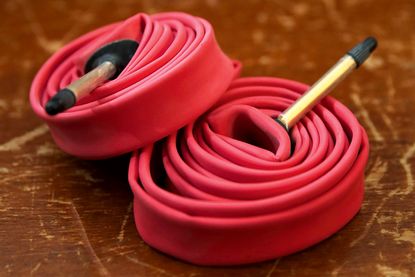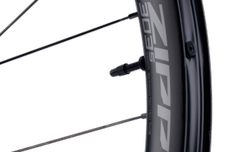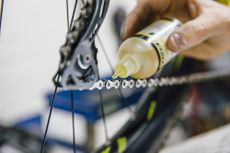Are latex inner tubes worth the hassle?
They’re expensive, high-maintenance and more likely to tear or blow but latex inner tubes offer a marginal gain that’s ideal for time trialling

Latex inner tubes are thinner, lighter and faster-rolling
Inner tubes fall into two different types: latex and butyl. Butyl tubes are the default choice for most of us and are fitted as standard on most bikes.
They typically cost around £4-5 in most shops. Butyl tubes are made from synthetic black rubber, while latex tubes are made from the sap obtained from rubber trees.
This rubber is far more fragile than butyl and owing to more time-consuming production, latex tubes are more expensive too. Butyl tubes work fine, so why would you choose to go latex?
>>> Are solid tyres worth a try?
In a word, speed. John Heasman, product promoter at Vittoria, the Italian tyre company, says that a “standard butyl tube adds roughly five watts per tyre” when compared with latex. Five watts might not sound like much, but over the course of long rides or time trials, it’s significant.
To find out whether this was just marketing I wanted to see for myself, so I conducted an experiment: I fitted Continental Grand Prix tyres with and without latex tubes, rode them on a set of rollers, measured the power with a PowerTap G3 hub and recorded the speed achieved for a given power output.
How to change a tube, when you need to
For consistency, the tyres were inflated to 100psi; each set-up was ridden at 280w for five minutes to allow it warm up, whereupon they were ridden at 300w for five minutes.
A constant riding position was maintained on the hoods and the weight of the bike and rider was reordered before each test. Any slight differences in weight or power output were factored into the final calculations.
>>> Is graphene cycling’s next game changer?
The fit. files were processed and the inertia was corrected for each tyre. The result was that latex tubes were five to 5.5 watts faster per tyre using this methodology.
The results were consistent with Vittoria’s claims and suggest that by using latex inner tubes you do indeed have lower rolling resistance, allowing you to travel faster for the same effort.
But, before we all go out and blow our hard-earned, are there any downsides?
Yes — cost. Latex tubes typically cost around £13 depending on the brand and where you shop. The rubber can also be damaged/compromised by oils and solvents. In my experience, as long as you don’t go spraying WD40 around like its Febreze you’ll be OK.
>>> Are 12-speed gears coming for road bikes?
Latex tubes are also more delicate, meaning installing them is more difficult. The main problem arises with seating the tube inside the rim and making sure it doesn’t get caught under the tyre bead.
If your rim tape is not properly installed, a latex tube is likely to find its way into small gaps, causing it to tear. None of this is a problem in tubular tyres.
Being thinner than standard tubes they are much lighter, too; a Challenge latex tube hit the Cycling Weekly scales at 54g, compared with 109 for a standard butyl tube.
>>> Is it the end for the 34t chainring?
However, being thinner, Heasman explained, “latex tubes are more prone to heat fluctuations and will likely blow out sooner than a butyl tube on heated rims through prolonged braking”.
Bear in mind that if you are faced with a long, wet or particularly technical descent, you may have no choice but to drag the brakes.
Heasman points out that this is a potential advantage “with disc brakes, where rim heat is irrelevant”.
Loss of pressure should also be considered with regards to latex as it is porous, meaning air leaks out of it.
I tested this and found that a 25mm tyre would go from 100 to roughly 85 psi overnight. This means you should be prepared to inflate your tyres before every ride.
Avoid punctures
Our take
For those using clinchers, the most obvious benefit is for time trialling where a five watt saving could be the difference between winning or losing. The risk of punctures remains the although this risk doesn’t outweigh the gain for such a relatively short time on the bike.
For everyday riding, however, you may want to rely on durability of a Butyl rather than the low rolling resistance of Latex, giving you a better chance of avoiding that inevitable puncture.
We ask the experts: Are latex tubes worth the hassle?
Yes: Jonathan Heasman, product promoter for Vittoria
Latex inner tubes are faster-rolling than the regular butyl tubes used by most riders and are much more supple.
This enables them to absorb the bumps in the road and flex around them better. As a consequence, the tyre is kept on the ground more than being bumped into the air with a butyl tube.
>>> Price reductions for Vittoria tyres in 2017
For added versatility our TNT Pitstop tyre sealant works perfectly well with latex tubes. Some latex-based sealant manufacturers suggest not to use their sealant in the latex tubes.
No: Mark Turner, Continental
For the pros we put latex tubes into our Competition Pro tubulars, however for consumers, there isn’t a latex tube that meets Continental’s minimum safety standards.
>>> Behind the scenes at Continental’s bicycle tyre factory
With heavy braking, such as while descending, you can cook the wheel rim and high temperatures can cause a latex tube to burst. Latex tube failure at 60mph could be life-changing.
As an alternative we offer a lightweight Supersonic butyl tube that is half the thickness of the standard Race 28 tube and weighs just 50g.

Thank you for reading 20 articles this month* Join now for unlimited access
Enjoy your first month for just £1 / $1 / €1
*Read 5 free articles per month without a subscription

Join now for unlimited access
Try first month for just £1 / $1 / €1
Get The Leadout Newsletter
The latest race content, interviews, features, reviews and expert buying guides, direct to your inbox!
Oliver Bridgewood - no, Doctor Oliver Bridgewood - is a PhD Chemist who discovered a love of cycling. He enjoys racing time trials, hill climbs, road races and criteriums. During his time at Cycling Weekly, he worked predominantly within the tech team, also utilising his science background to produce insightful fitness articles, before moving to an entirely video-focused role heading up the Cycling Weekly YouTube channel, where his feature-length documentary 'Project 49' was his crowning glory.
-
 'It's a surreal experience' - Meet the British teenager racing with his heroes
'It's a surreal experience' - Meet the British teenager racing with his heroesOli Peace is stepping up in his first pro race at the Tour of the Alps
By Tom Davidson Published
-
 A closer look at the 'disruptive' Ribble Rebellion crit bike: part artwork, part race machine
A closer look at the 'disruptive' Ribble Rebellion crit bike: part artwork, part race machineThe Ribble Rebellion team is riding an eye-catching bike for 2024, in more ways than one
By Joe Baker Published
-
 Tech Question: We're used to racers on narrow bars - but are they more comfortable, too?
Tech Question: We're used to racers on narrow bars - but are they more comfortable, too?We ask the experts what to look for in determining the optimal handlebar width
By Joe Baker Published
-
 Tech Question: Where do things now stand on press-fit bottom brackets? Good or bad?
Tech Question: Where do things now stand on press-fit bottom brackets? Good or bad?Few innovations have garnered as much animosity as press-fit bottom brackets - but the tech now has some strong proponents
By Stefan Abram Published
-
 Tech Question: Is a proper clean the only disc brake upgrade you need?
Tech Question: Is a proper clean the only disc brake upgrade you need?Bike mechanic and owner of Surrey Hills Cycleworks, Dave Farmer, shares his tips on how to improve braking performance
By Stefan Abram Published
-
 What are hookless rims and do you need them?
What are hookless rims and do you need them?With the big wheel brands launching new rims with straight sidewalls, we ask whether hookless technology can benefit your bike riding
By Simon Smythe Published
-
 Do you need indoor cycling specific clothing?
Do you need indoor cycling specific clothing?With an ever expanding range of indoor cycling kit available, we ask if it really makes any difference?
By Michelle Arthurs-Brennan Published
-
 Is a stiffer bike really faster?
Is a stiffer bike really faster?We take a closer look at one part of the holy trinity of frame design
By Michelle Arthurs-Brennan Published
-
 Will swapping your chain lube make you faster?
Will swapping your chain lube make you faster?Chain lube is coming of age - we explore some of the newest creations
By James Bracey Published
-
 How do you choose the perfect rim depth for you?
How do you choose the perfect rim depth for you?If money were no object, we'd all have a wheel wardrobe full of options. But for most of us, compromise is essential.
By Michelle Arthurs-Brennan Published